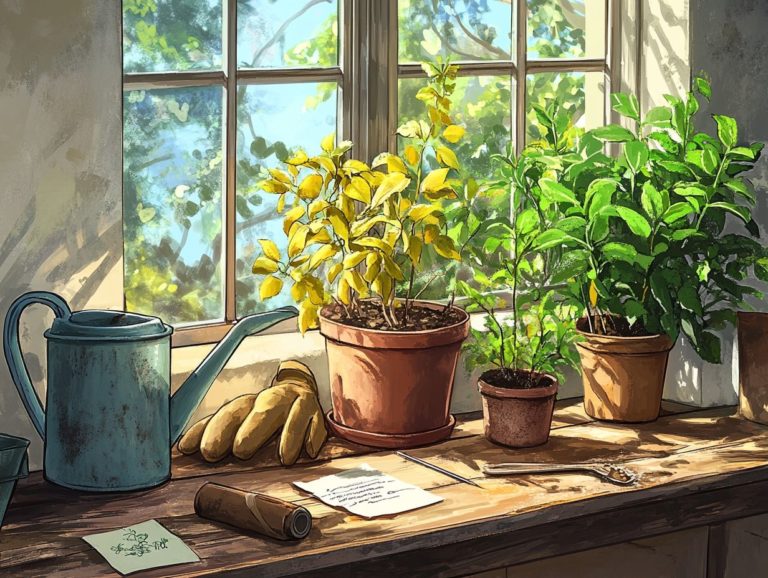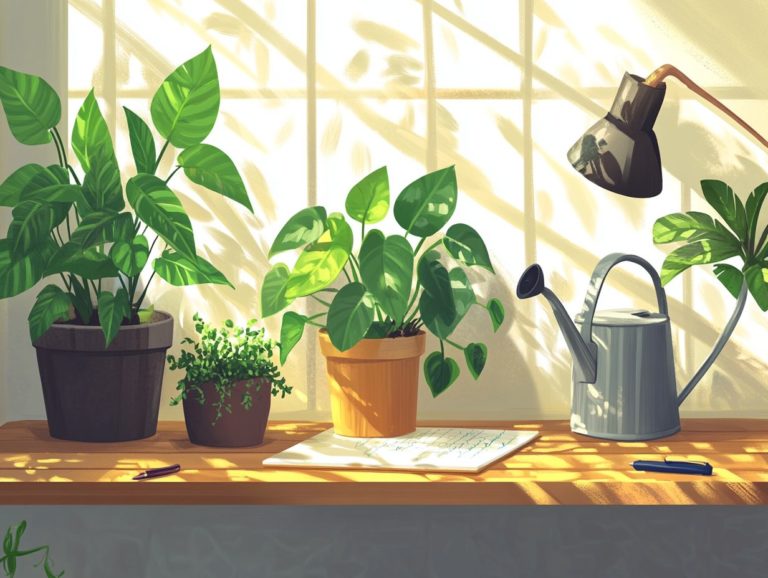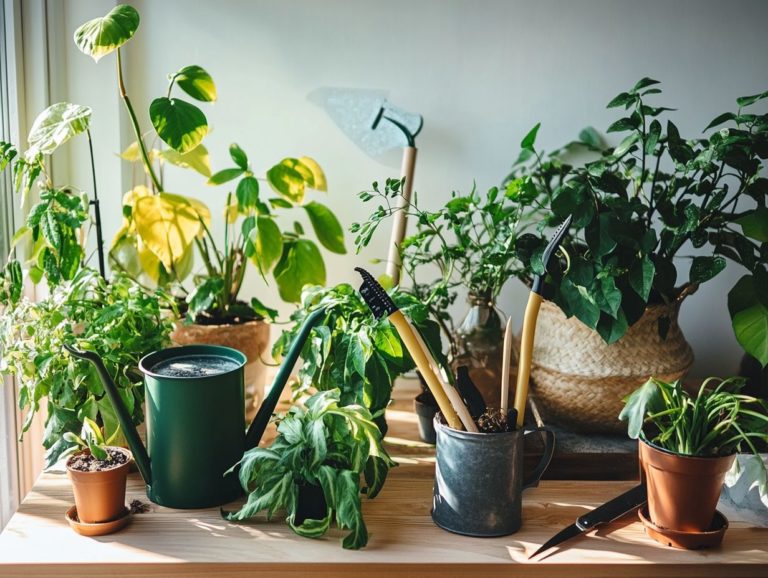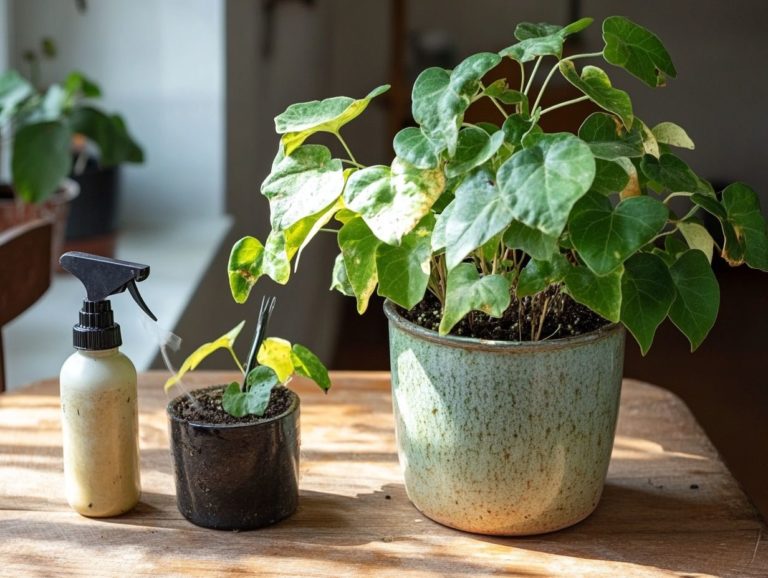Causes of Drooping Leaves in Houseplants
Houseplants infuse your home with life and vibrancy, but when their leaves begin to droop, it signals that your plant needs immediate attention!
Grasping the reasons behind this all-too-common issue is essential for any plant enthusiast.
Various factors, from lighting and humidity to potential pest infestations and nutrient deficiencies, can contribute to those sad, drooping leaves.
This article delves into these causes and offers practical tips to help you nurture healthy, thriving indoor plants that truly flourish in your space.
Contents
- Key Takeaways:
- Understanding Leaf Drooping in Houseplants
- Environmental Factors
- Pest Infestations
- Nutrient Deficiencies
- Root Issues
- Preventing Leaf Drooping
- Frequently Asked Questions
- What are the main common causes of drooping leaves in houseplants?
- How can I tell if my houseplant’s drooping leaves are due to underwatering?
- What about overwatering? How can I tell if that’s the cause of my houseplant’s drooping leaves?
- Can insufficient sunlight really cause drooping leaves in houseplants?
- How can I prevent root rot from causing drooping leaves in my houseplants?
- Are there any natural ways to get rid of pests that may be causing my houseplant’s drooping leaves?
Key Takeaways:
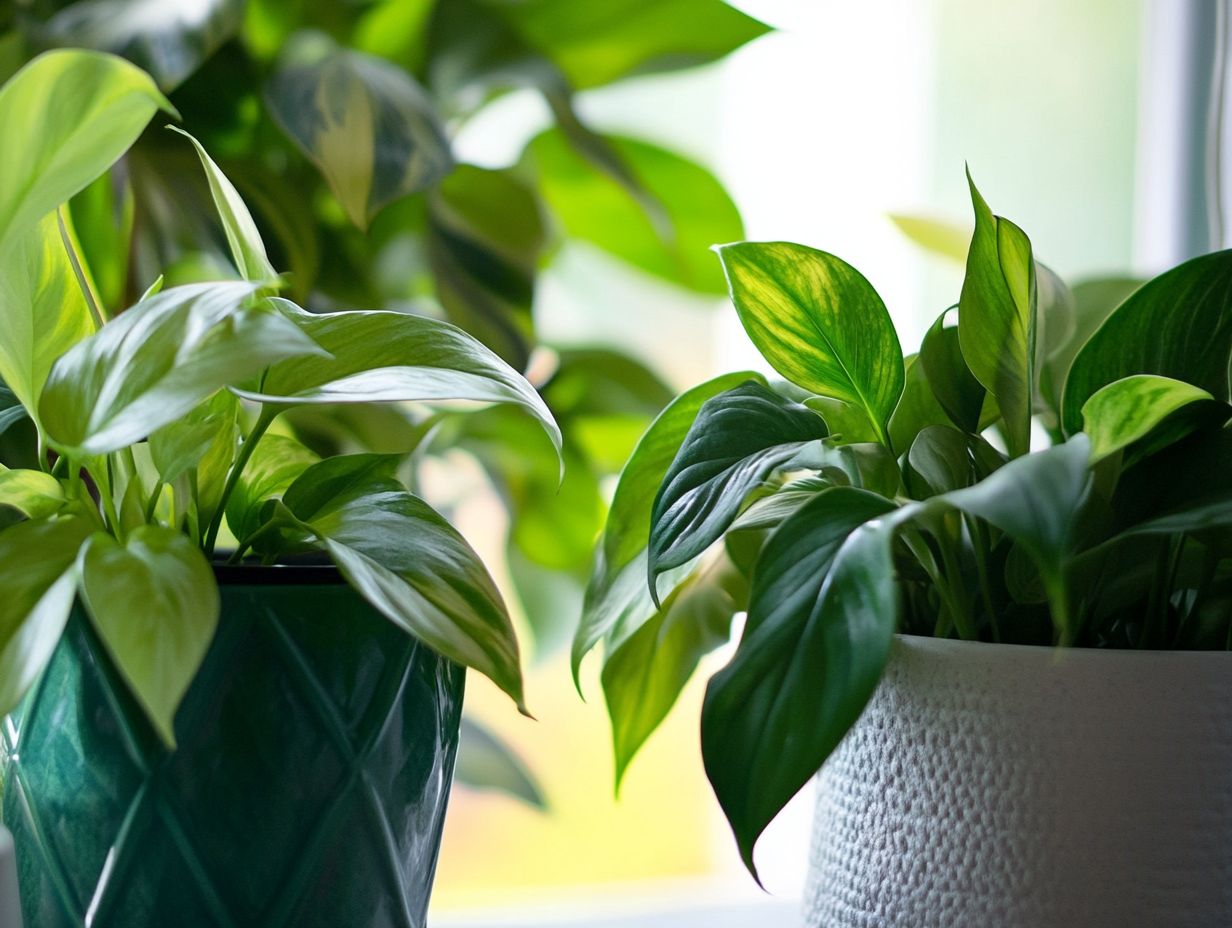
- Improper watering, lighting, and humidity can cause leaves to droop in houseplants.
- Pest infestations and nutrient deficiencies can also lead to drooping leaves in houseplants.
- Regularly checking and addressing environmental factors, pests, and root issues can prevent leaf drooping in houseplants.
Understanding Leaf Drooping in Houseplants
Understanding leaf drooping in your houseplants is crucial for anyone passionate about indoor gardening. Drooping leaves can signal a variety of issues impacting plant health.
Such symptoms often stem from stress from the environment think extreme temperatures or improper watering practices that can lead to conditions like overwatering or underwatering.
By pinpointing these common causes, you take the vital first step toward ensuring your houseplants not only survive but thrive, helping them bounce back from any distress they may encounter.
What Causes Leaves to Droop?
Leaves may droop for a variety of reasons, often tied to the delicate balance of your plant’s root system, which can be disrupted by either overwatering or underwatering.
This disruption can manifest as wilting leaves and soft stems.
When you give your plants too much water, their roots can suffocate, hindering their ability to absorb essential nutrients and oxygen. This creates a breeding ground for root rot, a condition where the roots decay due to excess moisture, which can severely compromise the plant s foundation and lead to irreversible stress.
On the flip side, when you don’t provide enough water, your plants can become dehydrated, causing their leaves to droop as they attempt to conserve moisture. It’s crucial to monitor soil drainage; well-draining soil allows excess moisture to escape while retaining just the right amount of moisture. Additionally, understanding the top causes of leaf drop in houseplants can help you keep your plants healthy.
By understanding the specific watering needs of your plants, you can significantly enhance their overall health, preventing damage from poor root conditions and ultimately cultivating a flourishing garden.
Environmental Factors
Environmental factors are pivotal to the well-being of your houseplants. Conditions like light availability, temperature fluctuations, and humidity levels can profoundly influence their growth and overall plant health.
By carefully monitoring these elements, you can create an optimal environment that nurtures your plants and enhances their vitality.
Lighting and Temperature
Sunlight exposure and room temperature are crucial for your indoor plants. If they don t get enough light, you might notice poor growth and drooping leaves.
Extreme temperatures can also add stress to their lives.
For many indoor plants, like succulents and cacti, bright, direct sunlight is essential. Tropical plants like Planta and Monstera also thrive in bright light, while ferns and peace lilies prefer the gentle touch of indirect light. Ignoring these light and temperature requirements can lead to serious consequences, like stunted growth, leaf discoloration, or even leaf drop in indoor plants, which can be the unfortunate demise of your plants.
When you maintain optimal conditions, not only do you encourage vibrant foliage, but you also enhance the overall ambiance of your living spaces. By understanding how to balance these factors according to the specific needs of each plant species, you can significantly improve their well-being, ensuring a flourishing indoor garden and a more inviting home environment.
Regularly check your plants and apply these tips for immediate improvement!
Humidity and Watering
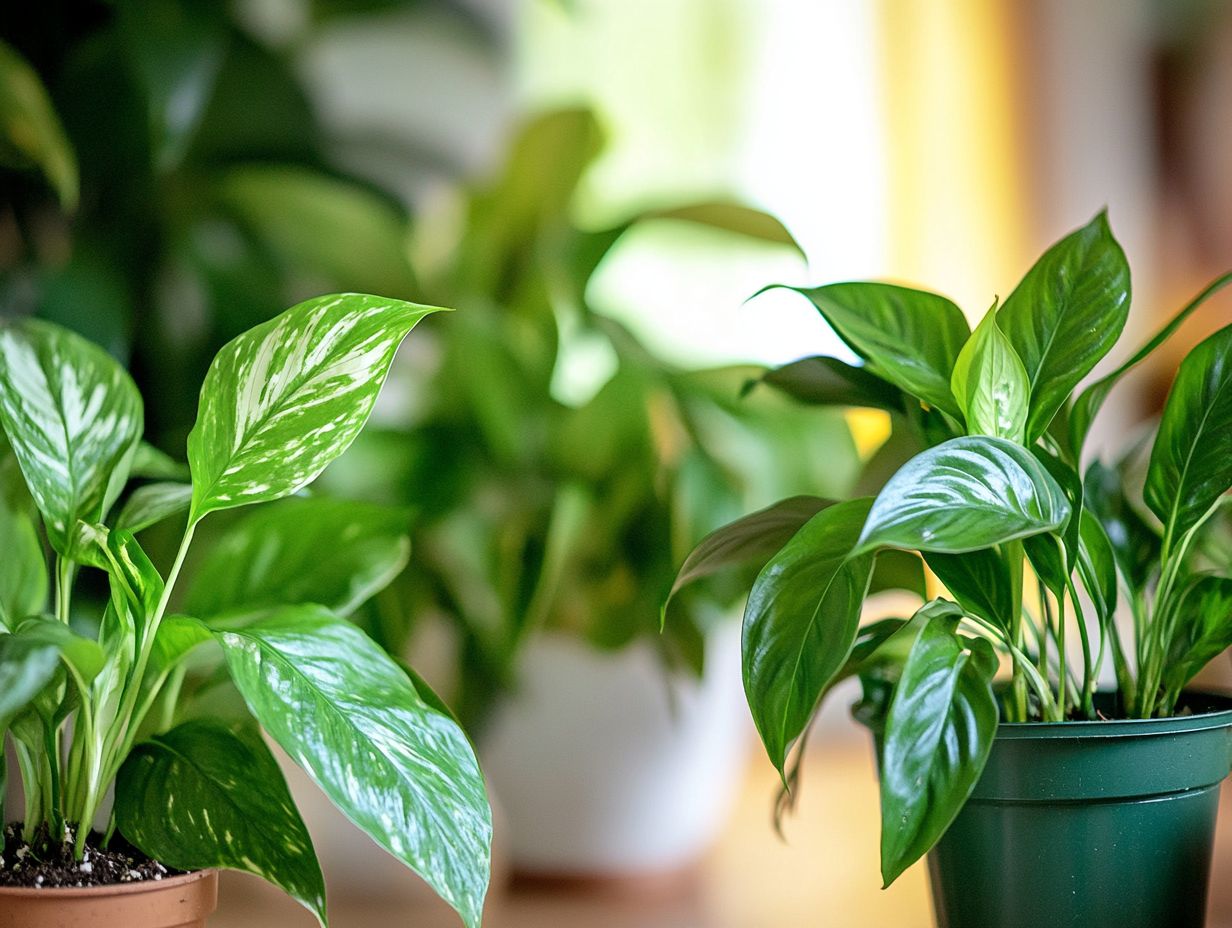
Humidity levels are essential for preventing moisture loss and maintaining the health of your houseplants. When humidity dips too low, you might notice drooping leaves and heightened watering demands.
In dry air, plants struggle to absorb enough moisture. This forces them to rely on more frequent watering to make up for the lost humidity. This struggle harms their vitality. It also affects the soil’s water retention, which can lead to overwatering or even root rot if not managed carefully.
To maintain optimal humidity levels, you can implement several effective strategies, such as:
- Misting the leaves regularly
- Using a pebble tray filled with water to create a microenvironment
- Investing in a humidifier to ensure consistent moisture in the air
Each of these methods is vital for supporting the well-being of your indoor plants, allowing them to thrive even in less-than-ideal conditions.
Pest Infestations
Pest infestations can significantly affect your houseplants, manifesting in troubling symptoms such as drooping leaves, leaf wilting, and a general sense of distress. Regular plant inspection is essential for maintaining their health and vitality.
Common Pests and Their Effects
Common pests like spider mites and mealybugs can wreak havoc on your houseplants, leading to distressing symptoms such as nutrient deficiencies that ultimately hinder recovery.
These pests feast on the plant s sap, disrupting the nutrient flow and causing yellowing or browning of the leaf edges. A weakened immune system makes your plants more vulnerable to diseases, creating a relentless cycle of decline.
To fend off these uninvited guests, adopt simple pest control methods. Keep a close eye on your plants! Regular inspections can keep pests at bay.
In the case of severe infestations, targeted insecticidal soaps or neem oil can work wonders, helping restore your plants’ vitality and allowing them to flourish once more. Act quickly if you notice pests; your plants’ health depends on it!
Nutrient Deficiencies
Nutrient deficiencies can manifest as drooping leaves and a general decline in plant health. Recognizing and addressing these issues is crucial.
Mastering this knowledge is essential for maintaining optimal indoor plant care and ensuring your greenery thrives in its environment.
Identifying and Treating Deficiencies
Identifying and addressing nutrient deficiencies is essential for the recovery and ongoing vitality of your houseplants, especially when you notice symptoms like drooping leaves.
Recognizing these signs early can significantly enhance your indoor plants’ overall health. Common deficiencies, such as nitrogen, phosphorus, and potassium, often reveal themselves through various indicators, including yellowing leaves or stunted growth.
To pinpoint specific deficiencies, pay close attention to the color, texture, and growth rate of the leaves. You should also consider conducting soil tests for a more precise diagnosis.
You can explore several treatment options, such as adjusting your fertilization routines, applying nutrient-rich fertilizers, or even repotting your plants in soil that’s been enhanced with essential nutrients.
Regularly monitoring and fine-tuning your care regimen will reinforce your plants’ health and ensure they thrive in their environment, highlighting the vital role nutrition plays in successful houseplant maintenance.
Root Issues
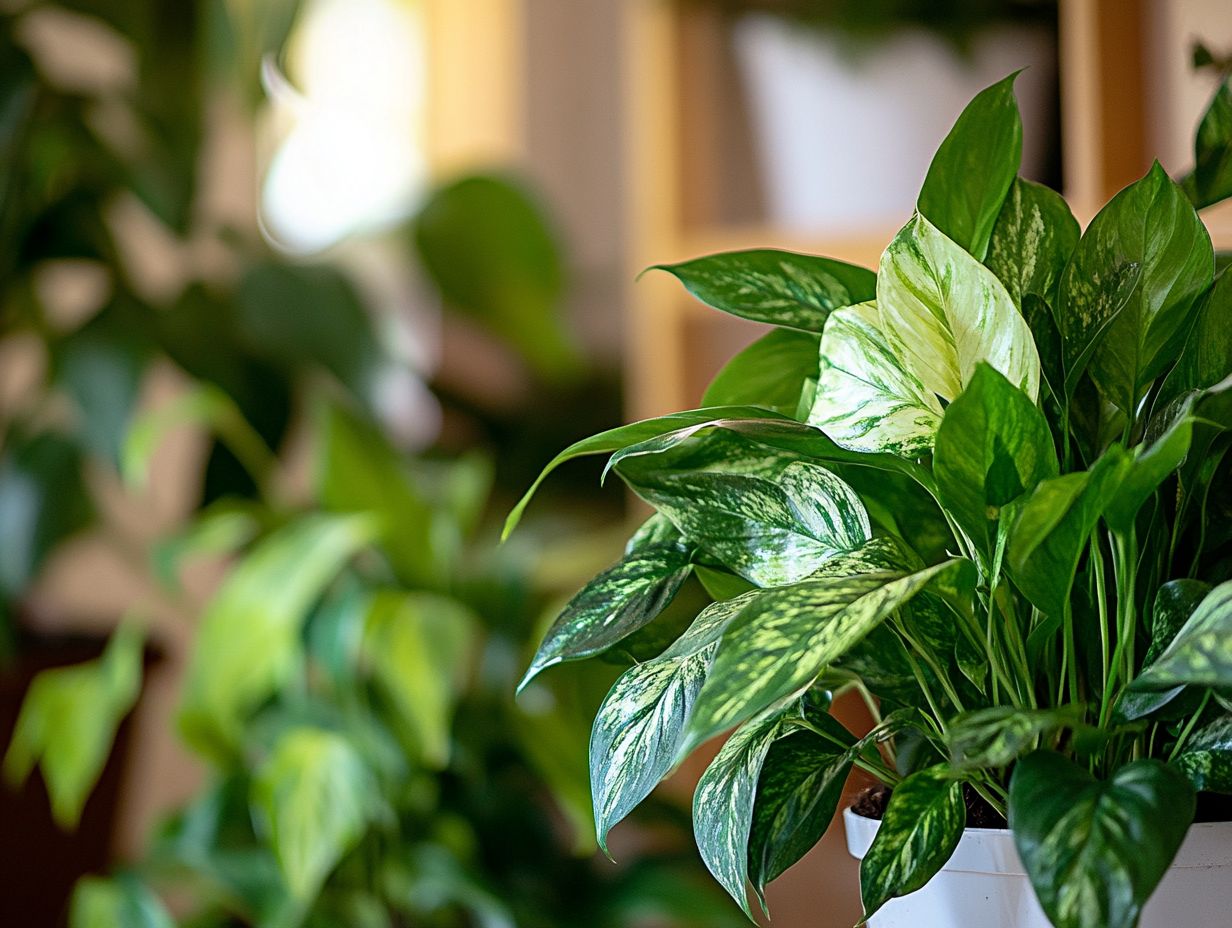
Root issues, like root rot (when roots decay due to too much moisture) and damaged roots, can create a delicate imbalance in the watering needs of your houseplants. This imbalance may manifest as dipping leaves and ultimately stifle the overall growth of your plants.
Root Rot and Other Problems
Root rot poses a significant threat to your indoor plants. It can lead to damaged roots and jeopardize their recovery and overall health if not addressed promptly.
This condition usually stems from overwatering, poor drainage, or using soil that retains too much moisture. These factors create a prime habitat for harmful fungi and bacteria, leading to nutrient deficiencies. As a result, the roots begin to decompose, severely limiting the plant’s ability to absorb essential water and nutrients. You might notice symptoms such as yellowing leaves, stunted growth, and a general decline in vigor. To learn more about this issue, check out the signs of overwatering in houseplants.
To combat this issue effectively, it s crucial to adopt preventive measures like:
- Using well-draining soil,
- Allowing the top layer to dry before watering,
- Ensuring pots have adequate drainage holes.
If you suspect root rot, gently remove the affected plant from its pot. Trim away any damaged roots with sterile tools, and repot it in fresh, dry soil.
Preventing Leaf Drooping
To prevent leaf drooping, adopt a proactive approach to your plant care. Establish a consistent watering schedule, monitor the environmental conditions closely, and ensure your plants have adequate support.
This thoughtful attention keeps your indoor plants thriving and vibrant while mitigating moisture loss.
Tips for Maintaining Healthy Houseplants
To keep your houseplants thriving and prevent issues like drooping leaves, follow this simple plant care guide. It covers watering needs, humidity levels, and overall growth.
By understanding the specific requirements of each plant species, you can create the perfect environment for them. Check the soil moisture before watering your plants. Most varieties thrive when the top inch of soil dries out, as dry soil can lead to underwatering (not giving enough water to the plant).
Humidity is another critical factor in their happiness. Consider investing in a humidifier or placing a tray of water with pebbles beneath the pots. This fosters a more suitable atmosphere, especially for tropical plants that require higher humidity levels. For additional tips on addressing challenges with your plants, explore easy solutions for common houseplant issues.
Position your houseplants where they can soak up just the right amount of sunlight. Avoid harsh light problems from direct rays. This thoughtful placement will help them thrive and enhance their vibrancy and overall health, contributing to better plant growth.
Frequently Asked Questions
What are the main common causes of drooping leaves in houseplants?
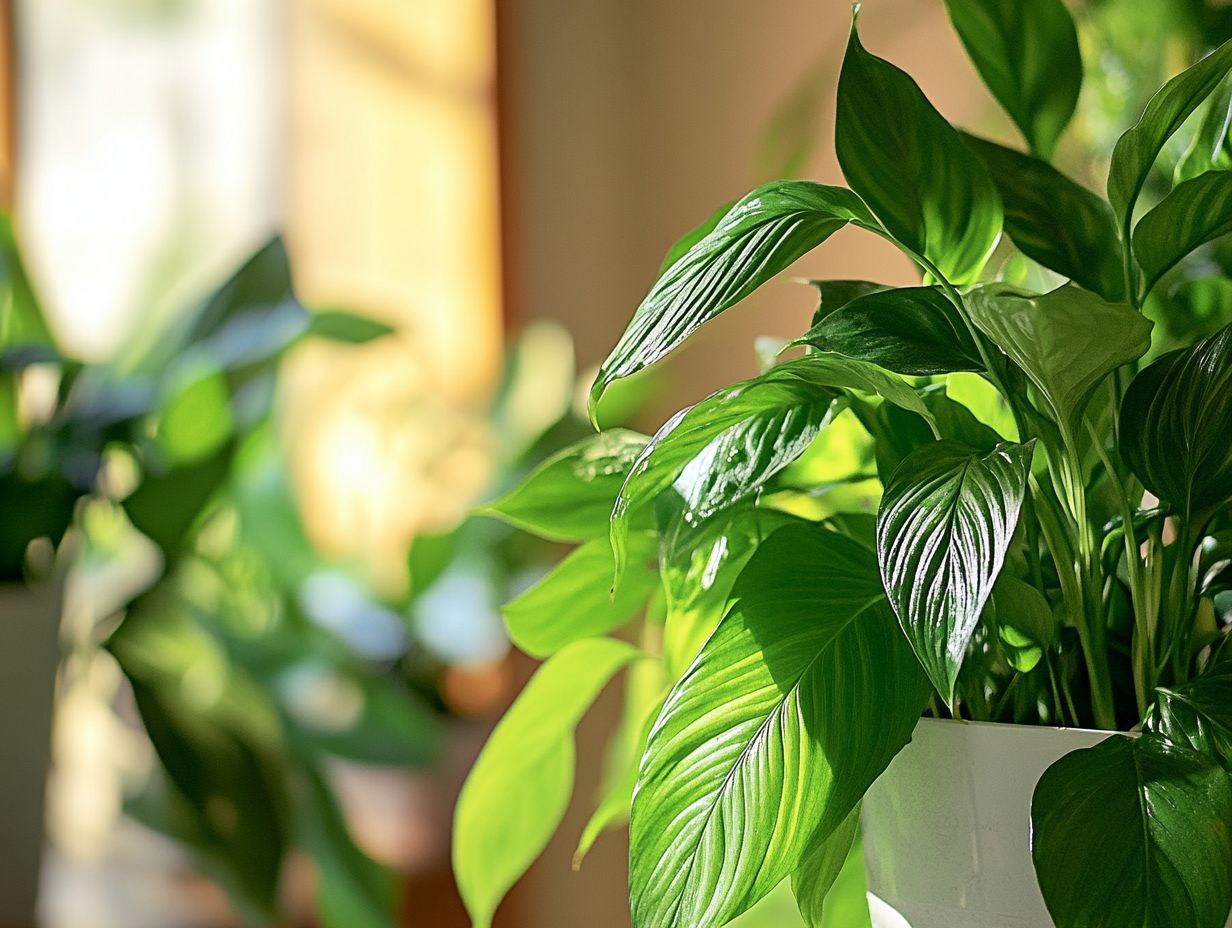
The most common causes of drooping leaves in houseplants are underwatering, overwatering, insufficient sunlight, root rot, pest infestation, and temperature stress.
How can I tell if my houseplant’s drooping leaves are due to underwatering?
If the soil is dry and crumbly, and the leaves are also dry and crispy, your houseplant is likely underwatered. You can check the bottom of the pot for roots sticking out or lift the plant to see if it feels light.
What about overwatering? How can I tell if that’s the cause of my houseplant’s drooping leaves?
If the soil is constantly soggy and the leaves are yellowing and wilting, your houseplant is likely overwatered. You may also notice a foul smell or the appearance of mold on the soil surface.
Can insufficient sunlight really cause drooping leaves in houseplants?
Yes, houseplants need adequate sunlight to photosynthesize and thrive. If your plant is not getting enough sunlight, it may become weak and droop its leaves as a result.
How can I prevent root rot from causing drooping leaves in my houseplants?
To prevent root rot, ensure your houseplant is not sitting in excess water and has proper drainage. You can also use well-draining soil and avoid overwatering.
Are there any natural ways to get rid of pests that may be causing my houseplant’s drooping leaves?
Yes, there are several natural remedies for pests and diseases in houseplants. Consider using neem oil, insecticidal soap, or introducing beneficial insects like ladybugs or predatory mites. These can help combat spider mites, mealybugs, and scale insects.
Start monitoring your plants today to enjoy a vibrant indoor garden! Remember, a little attention goes a long way in keeping your houseplants healthy.


